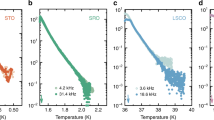Abstract
Superconductivity, the resistance-free flow of electrical charges, is one of the most exotic phenomena in solid-state physics. Even though it was discovered almost a century ago, many questions remain unanswered, in particular those concerning the physics of high-temperature superconductivity. The recent discovery of iron-based superconductors was arguably the most important breakthrough in this field for more than two decades and may provide new avenues for understanding this high-temperature phenomenon. Here I present my view of the recent developments in this field that have led to the current understanding of this important new class of superconductor.
This is a preview of subscription content, access via your institution
Access options
Subscribe to this journal
Receive 51 print issues and online access
$199.00 per year
only $3.90 per issue
Buy this article
- Purchase on Springer Link
- Instant access to full article PDF
Prices may be subject to local taxes which are calculated during checkout



Similar content being viewed by others
References
Pickett, W. E. The other high-temperature superconductors. Physica B 296, 112–119 (2001).
Mazin, I. I. Vitaly Ginzburg and high temperature superconductivity: personal reminiscences. Physica C 468, 105–110 (2008).
Kamihara, Y., Watanabe, T., Hirano, M. & Hosono, H. Iron-based layered superconductor La[O1−x F x ]FeAs (x = 0.05−0.12) with T c = 26 K. J. Am. Chem. Soc. 130, 3296–3297 (2008).
Mazin, I. I. & Antropov, V. P. Electronic structure, electron–phonon coupling, and multiband effects in MgB2 . Physica C 385, 49–65 (2003).
Mazin, I. I., Singh, D. J., Johannes, M. D. & Du, M. H. Unconventional sign-reversing superconductivity in LaFeAsO1−x F x . Phys. Rev. Lett. 101, 057003 (2008).
Kuroki, K. et al. Unconventional superconductivity originating from disconnected Fermi surfaces in LaO1−x F x FeAs. Phys. Rev. Lett. 101, 087004 (2008).
Mazin, I. I. & Schmalian, J. Pairing symmetry and pairing state in ferropnictides: theoretical overview. Physica C 469, 614–627 (2009).
Lee, P. A., Nagaosa, N. & Wen, X. G. Doping a Mott insulator: physics of high-temperature superconductivity. Rev. Mod. Phys. 78, 17–85 (2006).
Chu, P. C. W. et al. (eds) Superconductivity in iron-pnictides. Physica C 469 (special issue), 313–674 (2009).
Anisimov, V. I., Kurmaev, E. Z., Moewes, A. & Izyumov, I. A. Strength of correlations in pnictides and its assessment by theoretical calculations and spectroscopy experiments. Physica C 469, 442–447 (2009).
Yang, W. L. et al. Evidence for weak electronic correlations in iron pnictides. Phys. Rev. B 80, 014508 (2009).
Lee, C.-H. et al. Effect of structural parameters on superconductivity in fluorine-free LnFeAsO1−y (Ln = La, Nd). J. Phys. Soc. Jpn 77, 083704 (2008).
Hosono, H., Matsuishi, S., Nomura, T. & Hiramatsu, H. Iron-based superconducting materials. Bull. Phys. Soc. Jpn 64, 807 (2009).
Scalapino, D. J. Superconductivity and spin fluctuations. J. Low Temp. Phys. 117, 179–188 (1999).
Van Harlingen, D. J. Phase-sensitive tests of the symmetry of the pairing state in the high-temperature superconductors — evidence for d x 2 - y 2 symmetry. Rev. Mod. Phys. 67, 515–535 (1995).
Acknowledgements
I dedicate this article to the memory of Vitaly Ginzburg, a relentless enthusiast of high-temperature superconductivity and my former teacher, who passed away while this article was being written.
Author information
Authors and Affiliations
Ethics declarations
Competing interests
The author declares no competing financial interest
Additional information
Reprints and permissions information is available at http://www.nature.com/reprints. Correspondence should be addressed to the author (mazin@dave.nrl.navy.mil).
Rights and permissions
About this article
Cite this article
Mazin, I. Superconductivity gets an iron boost. Nature 464, 183–186 (2010). https://doi.org/10.1038/nature08914
Published:
Issue Date:
DOI: https://doi.org/10.1038/nature08914
This article is cited by
-
Unconventional Temperature-Dependent Critical Current in the Fe-Based Hybrid Josephson Junction with a Metallic Barrier
Journal of Low Temperature Physics (2023)
-
Crossover in Low-temperature Ground State of Fe(Se,Te) Compounds
Journal of Superconductivity and Novel Magnetism (2023)
-
Doping-dependent superconducting physical quantities of K-doped BaFe\(_2\)As\(_2\) obtained through infrared spectroscopy
Scientific Reports (2022)
-
Quasiadiabatic electron transport in room temperature nanoelectronic devices induced by hot-phonon bottleneck
Nature Communications (2021)
-
Electron–plasmon and electron–magnon scattering in ferromagnets from first principles by combining GW and GT self-energies
npj Computational Materials (2021)
Comments
By submitting a comment you agree to abide by our Terms and Community Guidelines. If you find something abusive or that does not comply with our terms or guidelines please flag it as inappropriate.



